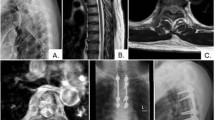Abstract
Spinal cord compression (SCC) is a relatively uncommon but frequently disabling complication of metastatic breast cancer. We have conducted this retrospective study of 70 patients with SCC secondary to breast cancer with the aims of determining risk factors for its development and predictors of outcome. Median age at diagnosis of breast cancer was 51 years with median time to SCC 42 months. All patients had radiological evidence of bone metastases at the time of SCC, and only five were not known to have bone metastases prior to SCC. The most frequent symptom of SCC was motor weakness (96%) followed by pain (94%), sensory disturbance (79%) and sphincter disturbance (61%). Ninety-one percent of patients had at least one symptom for more than a week. Radiotherapy (RT) was given as primary treatment in 43 cases, whilst 21 had decompressive surgery and seven of these went onto have postoperative radiotherapy. Six patients were deemed too unwell for either modality. Following treatment, 96% of those who were ambulant before therapy maintained the ability to walk. In those unable to walk, 45% regained ambulation, with RT and surgery being equally effective. Median survival following SCC was 4 months, with no significant difference between those treated by RT or surgery. The most important predictor of survival was ability to walk after treatment, followed by time from diagnosis of breast cancer to SCC. We conclude that the majority of patients have warning symptoms of SCC and that nearly all will have evidence of spinal bone metastases before compression occurs. The results suggest that earlier diagnosis and intervention could improve outcome. There was no evidence of benefit from surgery over radiotherapy as primary treatment, survival in both treatment groups being poor.
This is a preview of subscription content, access via your institution
Access options
Subscribe to this journal
Receive 24 print issues and online access
$259.00 per year
only $10.79 per issue
Buy this article
- Purchase on Springer Link
- Instant access to full article PDF
Prices may be subject to local taxes which are calculated during checkout
Similar content being viewed by others
Author information
Authors and Affiliations
Rights and permissions
About this article
Cite this article
Hill, M., Richards, M., Gregory, W. et al. Spinal cord compression in breast cancer: a review of 70 cases. Br J Cancer 68, 969–973 (1993). https://doi.org/10.1038/bjc.1993.463
Issue Date:
DOI: https://doi.org/10.1038/bjc.1993.463
This article is cited by
-
Computed tomography density changes of bone metastases after concomitant denosumab
Skeletal Radiology (2023)
-
A new and simple scoring system to predict overall survival after irradiation for metastatic spinal cord compression
Clinical and Translational Oncology (2020)
-
CT based quantitative measures of the stability of fractured metastatically involved vertebrae treated with spine stereotactic body radiotherapy
Clinical & Experimental Metastasis (2020)
-
Biomechanical Properties of Metastatically Involved Osteolytic Bone
Current Osteoporosis Reports (2020)
-
A novel rodent model of spinal metastasis and spinal cord compression
BMC Neuroscience (2012)



